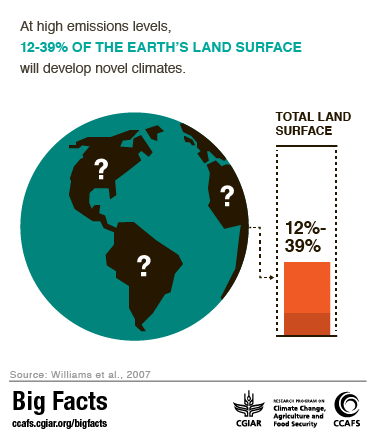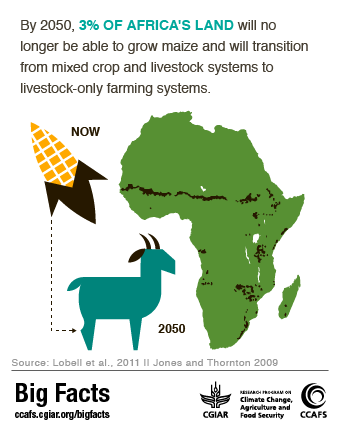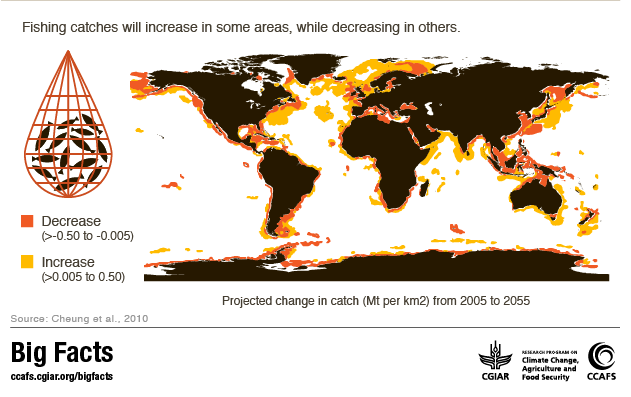Big Facts: Climate impacts on production

This story spotlights some of the Big Facts on climate impacts on production, and is part of a special blog series to complement the new Big Facts infographics website.
It is clear that climate change will have an impact on crops, livestock and fishing – and it is clear that this impact will be fairly large in some areas – what is not clear is how this impact will play out.
Some areas will benefit from increased temperatures; this will probably be the case in the relatively cold Northern/Northwestern Europe. Other areas will develop novel climates, completely new combinations of temperatures and seasonality of rainfall that have never before been experienced in human history. The challenge of adapting to climate change and finding suitable crops will be especially challenging in those areas, which Williams et al. 2007 estimated will cover as much as 12-39 % of the earth’s terrestrial surface at current high emissions levels.

In general, it is expected that climate change will impact agricultural production in two ways. First, there will be an impact due to increasing levels of climate variability: increased risk of climate-related disasters, which result from a combination of climate extremes and the exposure and vulnerability of natural- and human systems; more seasonal climate-variability (e.g. shift in runoff, unpredictable precipitation and seasonal warming). Second, there will be an impact due to long-term trends in climatic means, which could involve gradual change or, when thresholds are reached, non-linear changes.
Drought and floods to come hand-in-hand
With higher temperatures and changes to precipitation patterns, it is expected that by 2050, climate change will cause an increase in extreme droughts, especially in the subtropics and low- and mid-latitudes. Some areas will see increased precipitation, which will generally be concentrated into shorter rainfall periods - that is, more intense rain, increasing the risk of floods, but overall, the land areas experiencing increased water stress will be twice the size of those areas that will experience less water stress.
Uncertain crop changes to come
It is without doubt that climate change will impact crop yields, but due to large variation among locations and crop types, the resulting impacts are hard to estimate. Changes in yields of rainfed crops will be driven by changes in both precipitation and temperature, while changes in yields on irrigated land will be driven by temperature changes alone, provided enough water will be available to maintain irrigation, which in many regions is less than certain.
As climate change progresses and changes in temperature and precipitation sets in, it is increasingly likely that current cropping systems will no longer be viable in many locations. A study by Jones and Thornton (2009) found that, in Africa, maize cultivation will no longer be viable across up to 3% of the continent under both high and low emissions scenarios. These areas, which support 35 million people at present, are expected to switch from mixed crop–livestock systems to livestock only.

Livestock impacted through feed and pastures
Although switching to livestock systems will be an option for some people in some places, changes in climate and climatic variability is also expected to affect livestock farming, inevitably having an impact on the 1.3 billion poor people whose livelihoods are wholly or partially dependent on them. Thornton et al. (2009) found that climate change may affect livestock production most strongly by altering the quantity and quality of pastures and harvested feed available for animals.
Impact on fisheries not an even spread
The impact of climate change on marine fisheries is expected to differ significantly across the major marine fishing regions, as can be seen in the below map, developed by Cheung et al (2010) and reproduced by the CGIAR Research Program on Climate Change, Agriculture and Food Security (CCAFS). Some regions will experience a relative decline in catch and others a relative growth, but the outcome for people dependent on fisheries will also depend heavily on which fisheries policies are enacted in their region.

Forests ecosystems already responding
Increased CO2-concentration might have a ‘greening’ impact in some forests areas, but although climate change might be beneficial to some forest areas, it could prove disastrous for other areas. For instance, Allen et al. (2010) found that “forest ecosystems are already responding to climate change, raising concern that forests around the world are becoming increasingly vulnerable to higher tree mortality rates and die-off as a response to increases in drought-events and higher temperatures, even in areas that are – under normal circumstances – not considered to be water-limited”.
Sea level rise will lead to inundation and flooding of agricultural land
In the newest report by the Intergovernmental Panel on Climate Change (IPCC) it was found that global mean sea level rise for the 2081−2100-period relative to the 1986–2005-period, will likely be in the ranges of 0.26 to 0.82 m. This could lead to inundation and recurrent flooding in association with storm surges and saltwater intrusion in surface water, aquifers and agricultural land, posing problems for people who are dependent on these areas for drinking water, irrigation and farming.

HAVE YOUR SAY
As is probably clear from the above, the impacts from climate change on various aspects of food production will be numerous. Because of the inherent uncertainties of climate change, even our best predictions of those future changes are more or less uncertain. With Big Facts, we have tried to collect the best, most scientifically thorough and up-to-date research in various areas. I encourage you to explore the data on the Food Impacts Production page of the Big Facts website, and to consult the various references if you would like to know more. Should you have any comments on any of the findings, these are more than welcome. Simply comment below or send us an email.
Now you can get all the Big Facts on the links between climate change, agriculture and food security at ccafs.cgiar.org/bigfacts2014. The new site features over 100 stunning infographics that illustrate the most up-to-date, thoroughly researched information on these topics.
Big Facts is also an open-access resource. You can download and share the graphics with your friends and colleagues and use them in your presentations and reports. Please do not hesitate to send us any suggestions for improvements, either by commenting below or sending us an email.
This story is part of a series focusing on the Big Facts on various topics and in different regions; join the conversation at ccafs.cgiar.org/blog and on twitter using #bigfacts
